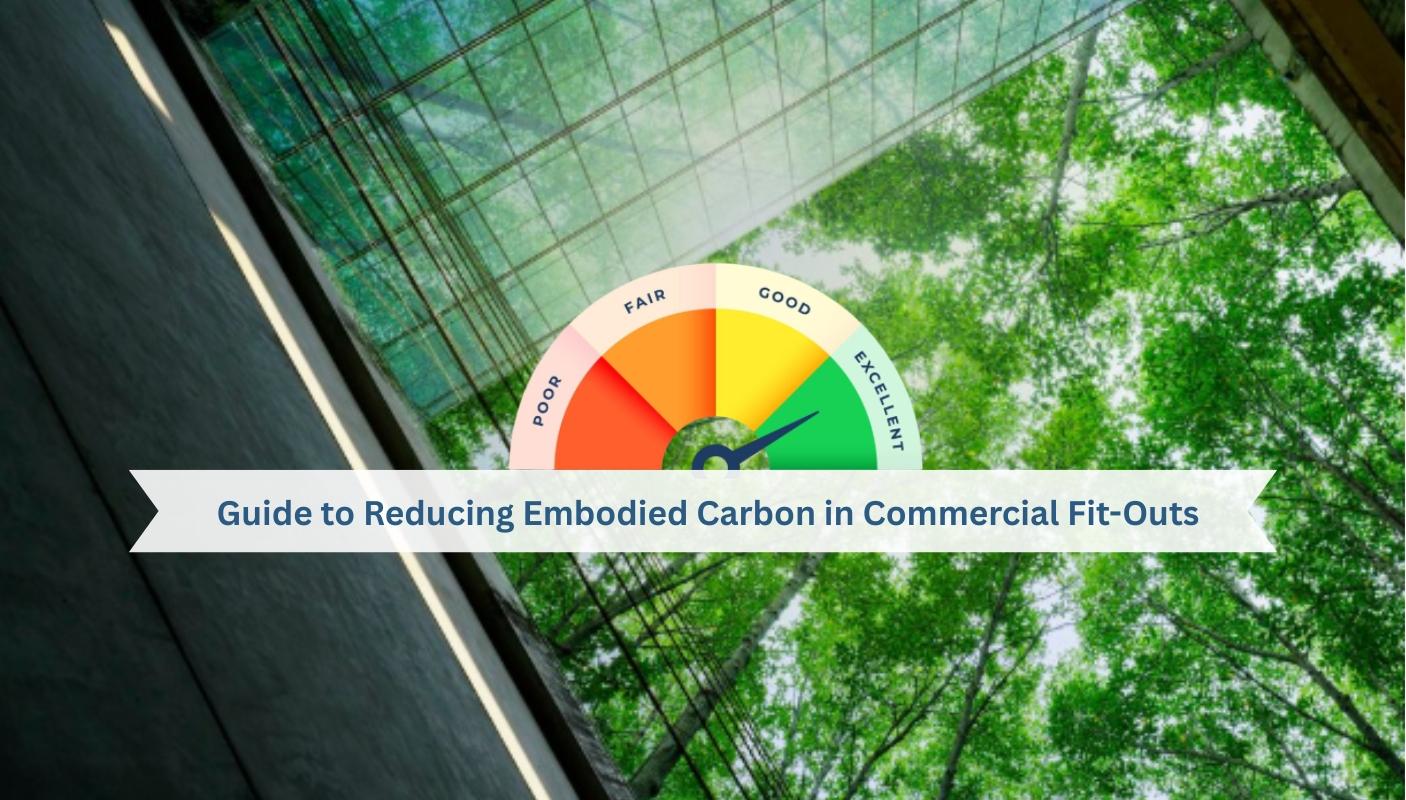Introduction
On the path to net-zero, operational carbon – heating, cooling, and lighting emissions from buildings – is rising up the priority list of UK commercial property owners. Embodied carbon – the carbon footprint of materials, building, and refurbishments – is a quiet contributor to overall emissions and EPC ratings.
With the government cracking down on MEES regulations on non-domestic buildings, understanding and minimizing embodied carbon is a compliance and competitive requirement for developers and landlords.
What is Embodied Carbon in Fit-Outs?
 .
.
Embodied carbon is all the greenhouse gas emissions involved in building materials and construction processes, including:
-
- Material manufacturing and extraction (steel, concrete, glass, timber)
- Transport and assembly
- Commercial fit-out replacement cycles
Whereas operational energy consumption influences day-to-day living EPC ratings, embodied carbon influences life cycle analysis and general building performance, increasingly being included in EPC Plus report for MEES compliance.
Why it Matters to Minimize Embodied Carbon

Raibuering the UK minimum energy efficiency standards EPC to solidify towards 2027 and 2030 targets, minimizing embodied carbon has:
✅ Enhanced sustainability credentials for tenant and investor attractiveness
✅ Enhanced EPC Plus report results, considering building materials’ influence on dynamic simulation modelling analysis
✅ MEES compliance for commercial buildings, particularly redevelopment or refurbishment schemes
Embodied Carbon Reduction Strategies for Commercial Fit-Outs
Select Low-Carbon Materials
-
- Use recycled steel, low-carbon concrete, and FSC timber
- Collaborate with material suppliers providing Environmental Product Declarations (EPDs)
Re-use and Refurbish Current Building Parts
-
- Reuse partitions, ceilings, and floor systems during fit-outs to reduce waste
Optimise Design with Dynamic Simulation Modelling EPC UK
-
- Commercial EPC Level 5 specialists at CCA Environmental employ sophisticated DSM software to simulate energy performance taking into account materials, design, and systems. This provides effective design with reduced embodied and operating carbon.
Start Early with EPC Consultants
-
- EPC consultancy for MEES legislation can enable design teams to include carbon saving measures early on in a building in an effort to prevent expensive retrofits down the line.
How Embodied Carbon Impacts EPC Ratings
Whereas standard EPC is concerned with efficiency of use, local Level 5 EPC assessors increasingly integrate embodied carbon into sophisticated modelling. For difficult buildings, the integrated approach improves:
-
- EPC ratings outcomes
- MEES exemption and EPC upgrades eligibility
- Future-proofing for future UK building decarbonisation law
EPC Plus Reports for Comprehensive Compliance

For property owners planning for MEES compliance deadlines, CCA Environmental provides EPC Plus reports for MEES compliance that combine operating and embodied carbon data. This enables owners to:
✅ Make plans for effective improvements
✅ Improve understanding of material selections affecting ratings
✅ Increase sustainability plans aligned with UK net-zero objectives
Discover more about our EPC Plus Reports for MEES Compliance here.
Working with CCA Environmental

At CCA Environmental, our Level 5 EPC assessor and commercial EPC specialists provide bespoke advice for:
-
- Single-let and multi-let office buildings
- Complicated redevelopments with dynamic simulation modelling EPC UK
- Strategic MEES compliance planning to preserve asset value and prevent penalties
Discover our Commercial EPC services.
Conclusion
Embodied carbon reduction is no longer a choice – it’s a strategic step towards:
✅ Improved EPC ratings
✅ Regulation compliance
✅ Improved environmental and bottom-line performance
Contact CCA Environmental today and integrate embodied carbon reduction into your EPC plan and keep your commercial properties competitive, compliant, and sustainable within the changing UK property market.

